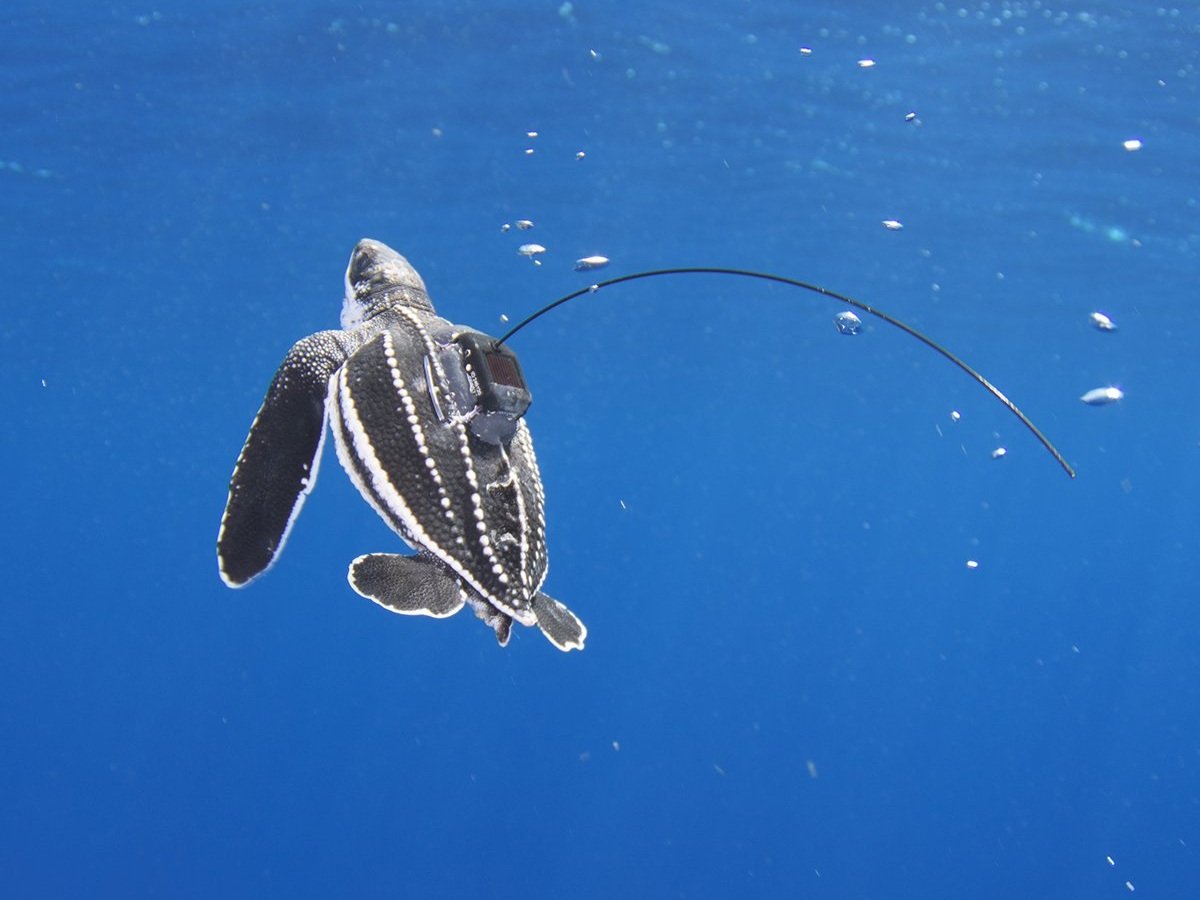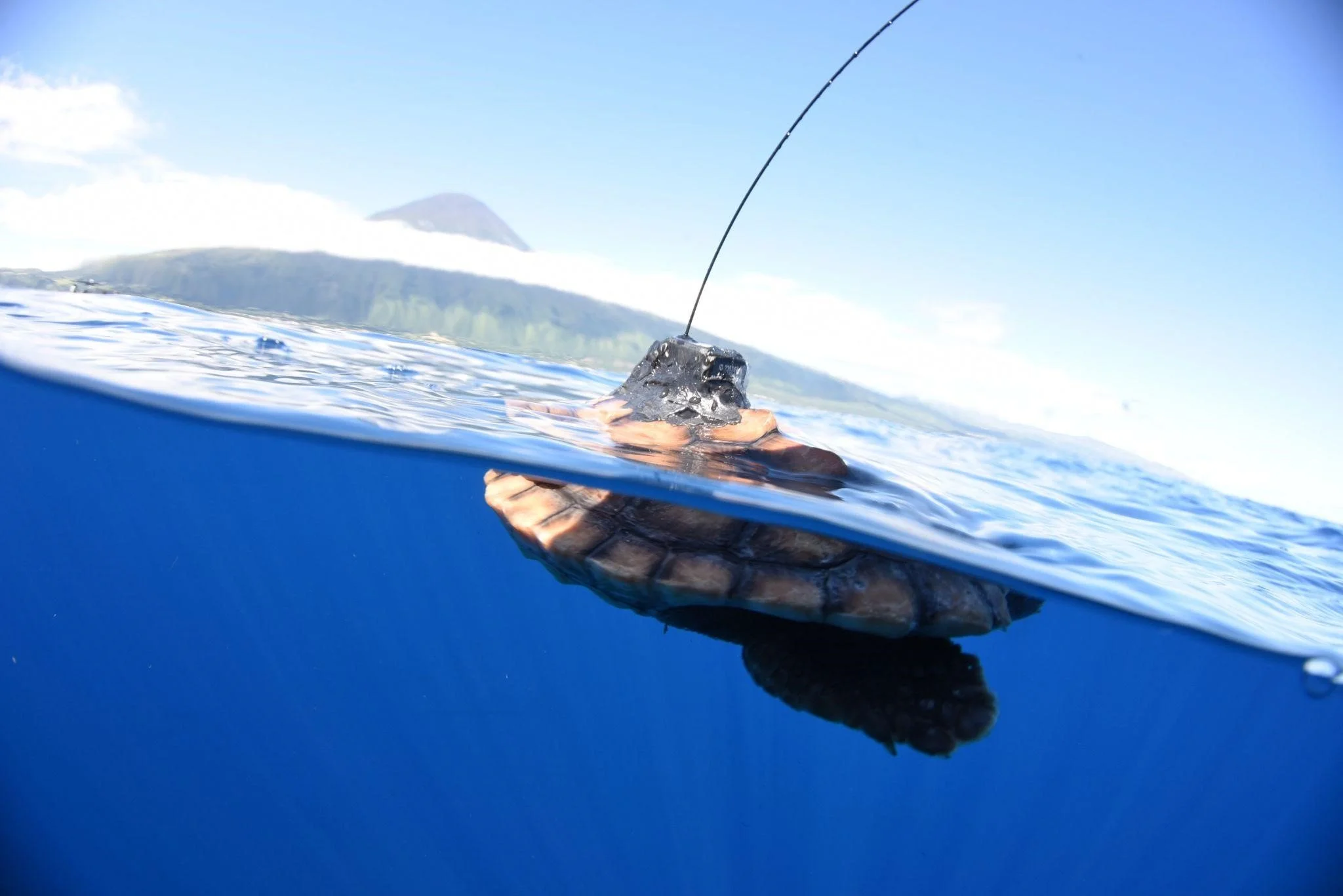Much of the current telemetry data collected by tagging hawksbills is from adult females, due to the fact that they are easiest to tag when they crawl up the beaches to nest. To expand our knowledge of small juvenile hawksbill movements, Upwell teamed up with ProTECTOR, Inc., an organization with the goal of advancing our understanding of sea turtle biology and ecology through research throughout the coasts of Honduras. In early July the collaborative team tagged eight juvenile hawksbills with micro-satellite tags. The turtles were then released just off of the northeast reef of the Bay Islands, with some making impressive journeys.
Loggerheads in the Bay of Biscay and Beyond
Last year in July, we deployed 10 micro-satellite tags on juvenile loggerheads in partnership with the Aquarium La Rochelle in France. Of this cohort, all of which are named after European scientists, the tags on turtles Archimede, Nicolas Copernic and Charles Darwin have continued to transmit for an astounding 312 days and counting (a new record)! As we prepare to release another set of turtles, we wanted to take a moment to reflect on some of the observations from this first deployment, and how they help us to take the next steps in our research.
Reflecting on the Sea Turtles in the Retroflection
Six months ago, Upwell and Two Oceans Aquarium deployed micro-satellite tags on 12 loggerhead turtles rehabilitated at the Turtle Conservation Centre. We watched their progress with many questions and hypotheses. While it will take far longer than six months to answer any of these questions fully, we made some fascinating observations that allow us to ask even more questions!
Where do you spend your lost years, little turtle?
In late October, a collaborative team of researchers from Two Oceans Aquarium Foundation and Upwell took a boat into the swift Agulhas Current, the southwest boundary current of the Indian Ocean that runs down the east coast of South Africa. There, they released 12 tiny loggerhead turtles with satellite tags attached to their carapace (top shells) in an effort to understand how these turtles are using this oceanic highway. See where these turtles have traveled over their first weeks in the ocean!
Collaborative Research Tracks Loggerhead Sea Turtles During Their Early Life Stages
Tagging Juvenile Loggerheads in the Bay of Biscay
Upwell’s Executive Director, Dr. George Shillinger, recognized that the rehabilitated early-stage juveniles at the Aquarium La Rochelle CESTM were perfect candidates for Lotek microsatellite tags and invited CESTM to join Upwell’s Lost Years Initiative, kicking off the collaboration with the tagging of 10 juvenile loggerheads in late July. Over the past two months, the turtles have shown a range of behavior, including surprisingly deep dives for turtles of such a young age!
New Collaboration to Tag Juvenile Leatherbacks in Thailand
In early April, Upwell partnered with the Phuket Marine Biological Center (PMBC) in Thailand to tag and release 11 juvenile leatherbacks, each around 1-year old. This release was the latest collaboration in Upwell’s Lost Years Initiative, an international effort to collect data on the movements and behaviors of early stage juvenile turtles.
Researcher Interview: Analyzing Data from Microsatellite Tags on Juvenile Sea Turtles
With a team of collaborators, we tested new specially-designed prototypes of Lotek microsatellite tags on 160 juvenile sea turtles of four species in the North Atlantic. The data from these tags was published in a new article, "Novel Microsatellite Tags Hold Promise for Illuminating the Lost Years in Four Sea Turtle Species." We sat down with lead-author Tony Candela to talk about this article, his process as lead-author, and the important implications of these findings for the bio-logging community.
Trans-Atlantic Collaboration Tracks Turtles into their Lost Years
Upwell’s efforts to learn more about the lives of juvenile loggerheads in the Atlantic expanded from Florida to the Azores, and now, to South Africa. Through a new collaboration with the Two Oceans Aquarium Foundation, Upwell Executive Director Dr. George Shillinger traveled to Cape Town for the tagging and release of rehabilitated juvenile loggerhead sea turtles. The Two Oceans Aquarium Foundations' Conservation Manager, Talitha Noble, wrote this post to provide some insights on why learning more the movements of young loggerheads at this juncture between two oceans is so important.
Following Tiny Turtles at Sea Part II: Tag Deployment
As you may have read about in our previous blog, Upwell developed prototype micro-satellite that are lighter than a penny to follow juvenile turtles at sea and learn more about the life phase known as the Lost Years. This data helps us to piece together the various routes juvenile turtles of different species and populations follow as they cross ocean basins for the first time. Read part two of our “Following Tiny Turtles at Sea” blog post to learn about how we release tagged turtles and plan to mobilize the data we collect.












